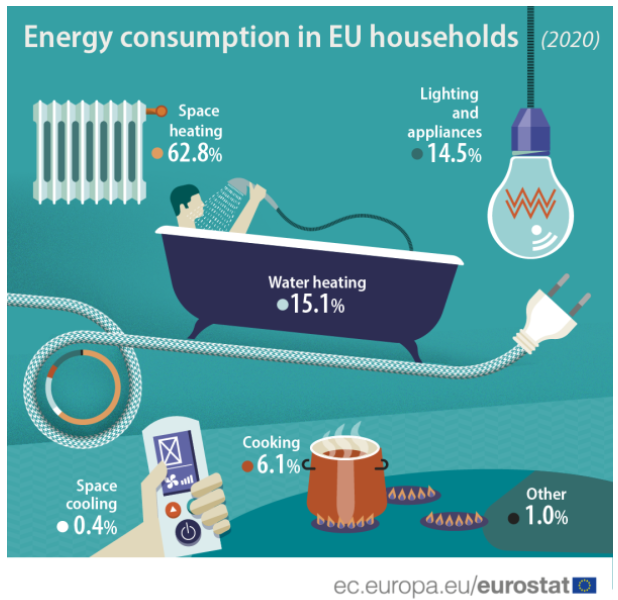As households across the world wrestle with rising prices, it’s making us all look harder at how we can cut bills and consumption.
Let’s be clear at the outset, this is NOT an argument that all we need to do is turn off a few lights and the energy crisis will go away. For many countries, and the UK in particular, it’s clear that the sheer scale of this crisis – and rising bills – is going to require massive policy interventions on price and support.
The scale of the challenge is likely to require a ‘fusion’ response: one that combines several elements of demand reduction, structural changes to supply, as well as direct support on costs. Modest shifts in demand can also have disproportionate impacts in energy systems where there is a strong non-linearity to the price curve (cf how global energy prices bounce around on the prospect of relatively modest percentage movements in anticipated supply and demand).
Behavioural interventions by households can also have another important benefit: they can re-inject a genuine element of agency and control.
So with these caveats in mind, let’s have a quick canter through what consumers really might be able to do to reduce their energy consumption, and importantly, what might be some of the less obvious barriers that get in the way. Finally, we’ll turn back to the policy implications, including the case for ‘block pricing’: a lower cost base-tariff for the first slug of ‘unavoidable’ energy we use, alongside a standard (or higher) tariff for higher ‘lifestyle’ users.
‘Top-tips’ for reducing household energy
Most of us don’t have a very clear mental map of how much energy it takes to do what. Visible items and behaviours, such as turning off lights, tend to catch our attention, whereas less visible but potentially more impactful actions, such as defrosting our fridge-freezers or turning down the boiler flow temperature, can pass us by.

It’s a pattern we have seen in a number of areas, not least in work we did in the run-up to COP26. This showed that, while most people were willing and keen to take actions to reduce their carbon footprint, their knowledge of the scale of impact of different actions was weak (indeed, there was literally a weak negative(!) correlation between estimated and actual impacts). So let’s start with a quick summary of what we actually spend our energy bills on….
Nearly two-thirds of our energy consumption is on ‘space heating’. This also explains why, for most households, the significant majority of our annual energy use occurs in the winter months (in Northern Europe). This takes us to a relatively familiar list:
- Insulate! At the very least, obsessively go round your home identifying and blocking drafts and gaps, including keeping doors shut within the household.
- Heat the person, not the space. Turns out that Grandma was smart to use a hot-water bottle in bed. Similarly, turn off the heating in rooms not in use, and learn to love those snuggly warm jumpers. Indeed, we might all do well to learn from the adage of wise outdoor instructors – ‘its easier to stay warm, than get warm’ – so discover the wonder of underlayers on legs as well as arms.
- Lower the flow-rate temperature of your heating system.
It’s worth noting that the average internal temperature of homes has risen substantially over our lifetimes. For the UK, average winter home temperatures rose by more than a degree centigrade per decade from 1970 to 2010. This was driven by at least three factors: the rise of central heating (heating the whole house, rather than just the rooms we were in); better insulation (surely a good thing – and helping to lower bills even as internal temperatures rose); and changing habits (why shouldn’t I wear a T-shirt all year round?)
Let’s not trivialise. There are many older and financially strapped people who, even before the current crisis, struggled to heat their homes in winter. This is brutally captured in the excess winter death stats: for every one degree colder than average the UK winter, around 8,000 extra people die. There are clearly a host of vulnerable people who we should be supporting to heat their homes more. But it is also the case that for many of us, we could heat our homes a little less, and in so doing save a heap of energy – both for ourselves and others…
Into the fray
Next on the list is the 10-20 percent we spend on heating water, in other words, for showers and baths (people with electric showers need to really pay attention to this, as electricity is 3.5 times as expensive as gas per kWh). At the risk of a whole world of pain and controversy, let’s at least put our toe in the (hot) water… (cue twitterstorm).
Increasingly, most people have a shower (now less often a bath) every day. Curiously, it’s not what dermatologists recommend. If we listen to the experts, they suggest a shower every other day, or one in three. Showering more often than this depletes our skin of natural oils and disrupts the natural (good) bacteria on our skin. Ironically, we end up having to spend a small fortune on conditioners and moisturisers, replacing the natural oils that the soaps and shampoos just removed.
It is a curious state of affairs, and with a pretty strong behavioural element. It’s a very simple daily habit loop. Get out of bed (trigger), have a shower (behaviour), feel refreshed (reward). It’s no longer just about hygiene per se, but about ‘waking up’, smelling nice, having a quiet moment to reflect. And prompted and reinforced by a million adverts for all the products involved in the process, and built into the loop.
But seems a pretty good time to reflect on whether other, less energy consuming alternatives to the loop might be in order. Switch from ‘get up’ —> ‘have a shower’ , to ‘get up’ → splash face with cold water, and breathe deeply for 20 seconds. Or switch from ‘get up’ as the cue with ‘had exercise’. Or just go for cold showers.
Implications for financial help
It is hard to see a world in which governments and regulators aren’t going to have to spend billions on subsidies, and/or revisit the link between cost of energy production and price.
If we think there is a range of changes that households can reasonably and rapidly make (such as turning down flow temperatures or taking fewer showers), and also a ‘behavioural’ or energy floor that it is hard to go below, it would make sense to echo this in the design of incentives or subsidies.
In essence, it suggests a strong a priori case for some version of ‘block pricing’. This means focusing subsidies on core or irreducible energy use (say the first 50% of the average household use), but tapering them away sharply for energy use above this level. It’s also possible that this could be progressive since wealthier households tend to spend considerably more on energy – though lower as a proportion of income – than less wealthy households. This is very close to proposals tabled by Policy Exchange over the last day or so.
Of course, tricky policy questions would still remain. Should the baseline factor in the number of people in the household? What about households with someone living with a disability (likely needing additional support through benefits)? Should the baseline factor in the insulation level of the house, for example weighting the baseline payment to EPC (risks moral hazard issues in medium term, but would appear fairer with respect to urgent action)?
Finally, there is an interesting potential difference of view between a subsidy designed on classical economic principles, versus one based on behavioural economics. The text book view would be that it’s better just to give the cash equivalent to consumers, let the market set the energy price, and allow individuals (‘utility maximisers’) decide how to spend the money and/or adjust their behaviour.
But if behaviour is only malleable over a given range, it may be better to focus attention and incentives on that range. There are also well-documented ‘mental accounting effects’: humans put money into mental or literal jars. Hence, people who received money for winter fuel allowances did disproportionately spend this money on extra fuel, not other expenditure [note: it would also have been good to have allowed people to bundle together several years of such allowances to fund insulation!].
In sum, soaring energy prices are at the top of the in-tray of the incoming UK PM, and of every leader in Western Europe. Complementing and shaping our support packages with an understanding of the drivers and malleability of demand is likely to get a much bigger bang for our buck, and empower the public to play a part too…




